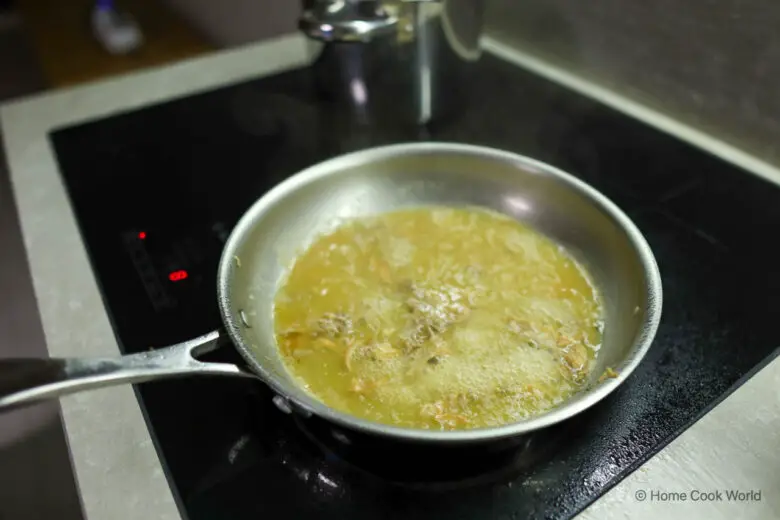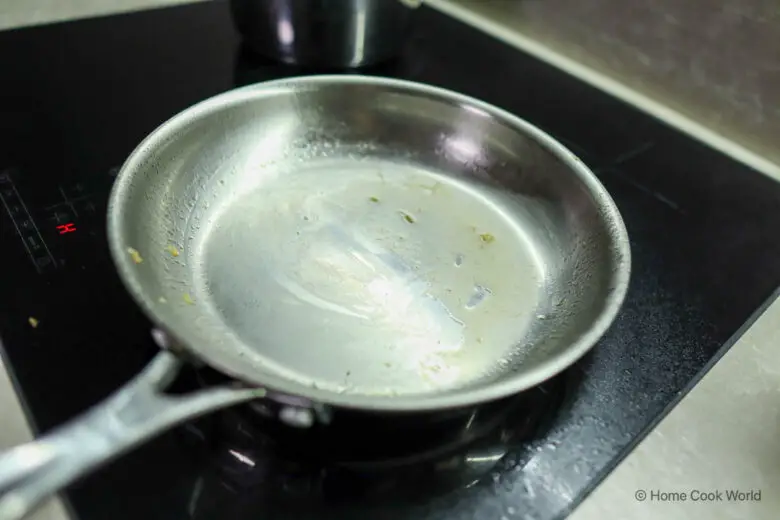There’s a reason why stainless steel frying pans are a favorite of professional chefs and seasoned home cooks alike. They’re great for searing meat, poultry, and fish, sautéing vegetables, and making the most delicious pan sauces. Stainless steel cookware has no ceramic or non-stick surface to worry about, and they’re generally easy to clean as they can go safely in your dishwasher.
There are two sides to every coin, at least, and stainless steel frying pans have their drawbacks. If you ask me, the biggest drawback of them all is the fact that food, especially high in protein and low in fat, tends to stick to the bottom of the pan.
Food will stick to your pan every so often, even if you have the best cooking technique you could possibly imagine. It’s just too easy to get one variable, like not preheating your pan for enough time or forgetting to bring your food up to room temperature, wrong.
This happened to me last week as I made pan-seared salmon. Don’t get me wrong; the salmon came out fantastic. But bits and pieces of it had stuck so well to the bottom of my pan, it was going to be nothing short of a nightmare to clean.
Happily, I have a foolproof technique for cleaning salmon off of a stainless steel frying pan that’s worked consistently for me every single time I’ve tried it. And, in this post, I’m going to share it with you.
To get stuck salmon off of your stainless steel frying pan, fill it with tap water and add 3-4 tablespoons of vinegar to it. Bring the solution to a boil and let boil for 5-6 minutes. The burnt oil or fat on the bottom of the pan will dissolve and the bits and pieces of salmon will get unstuck.
It’s done when you grab the pan tightly by the handle, take it off the heat, tilt it to the side, and nothing’s striking to the bottom or the sides—all the food residue is floating freely in the acidic water. Use a silicone or wooden spatula to scrape off any unexpectedly stubborn pieces.



Vinegar cleans stainless steel frying pans so well because it’s highly acidic (most kinds of vinegar sold at the grocery store have 5% acidity). It cuts through grease and grime and helps to get burnt-on food particles unstuck from the bottom or sides of the pan.
I’ve used distilled white vinegar and apple cider vinegar for this technique, and they worked equally well. I’m sure red or white wine vinegar will do well.
Avoid balsamic vinegar and other dark-colored vinegar; they’re expensive and you could probably find better uses for them in your salad dressings, pan sauces, and gravies.
I saw that other bloggers out there were recommending solutions as concentrated as 1 part vinegar, 3 parts water. I’m no chemist or metallurgist, but I’d avoid boiling overly-acidic solutions in a stainless steel pan or pot for too long.
Let me know in the comments section below this post if the amount of vinegar I proposed ended up working for you. For me, it gets the job done every single time.
After you’re done, discard the acidic water and food particles in your kitchen sink. If you don’t have a garbage disposal unit, be sure to use a kitchen sink strainer (or simply run the acidic water from the pan through a sieve). Otherwise, you could end up clogging the drain pipes.
Will Vinegar Damage a Stainless Steel Frying Pan?
It can be confusing to keep up with all of the myths and misconceptions about what is safe for your cookware! One common misconception involves using vinegar on stainless steel.
Is it okay to use vinegar on a stainless steel pan?
Household vinegar, which is typically sold in concentrations of 4-8%, isn’t concentrated enough to cause any damage when used as a cleaning agent on stainless steel cookware. In fact, many store-bought cleaning sprays contain vinegar or its active ingredient, acetic acid.
This is the reason why so many home cooks prefer a solution of vinegar and water over the chemically-harsh cleaning agents sold in supermarkets.
A solution of vinegar and water brought to a boil can help you clean food residue, white spots, and rainbow streaks off of your frying pans.
In Conclusion
The quickest and easiest way to remove bits and pieces of salmon stuck to your frying pan? Fill the pan with water, mix it with household vinegar, and bring the solution to a boil.
After 5-6 minutes, the burnt oil will have dissolved in it and the leftover pieces will be floating in the water, allowing you to finish cleaning the pan by hand or put it in the dishwasher.
If you found this post useful and are wondering what to read next, I wrote a whole post about how to keep salmon from sticking to stainless steel frying pans. No more glued skin and fillets broken into pieces!

